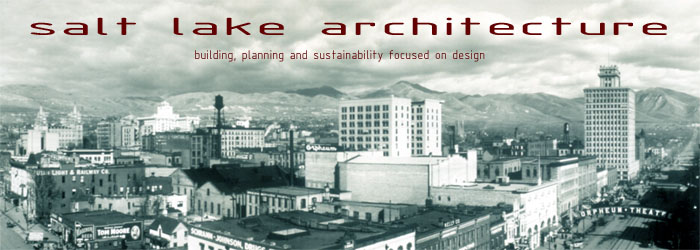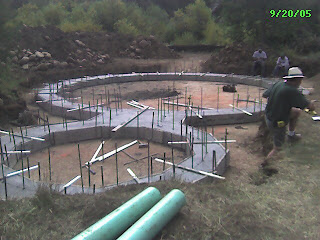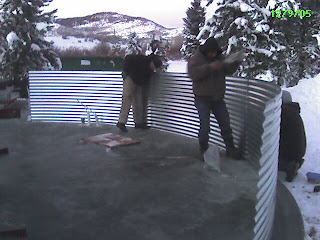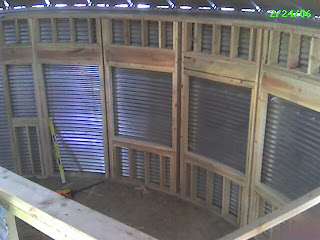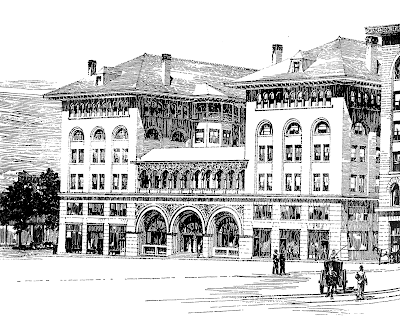
(Perspective of Ontario Hotel. From The Inland Architect and News Record, Nov 1891, Vol XVIII, No. 4)
"The new Hotel Ontario is the talk of the town. There are a few doubting Thomases, but the solidity of the names in the list of the incorporators make of the scheme an assured success. There is great wealth behind these incorporators, and a hotel is to go up corner of West Temple and Pierpont streets that will be an ornament, an honor and a convenience to the entire west. The promoters aver that there is to be no fooling over this thing; they are in for keeps, and that building is going up as soon as arrangements can be made to start." (Salt Lake Tribune 26 Dec 1889)

(Perspective of Ontario Hotel. From Salt Lake Tribune 01 Jan 1891)
The Hotel Ontario
A View of the Finest Hostelry in the Mountains
It Will Be Six Stories High and Will Have Every Modern Convenience and Comfort – A Strong Company Putting It Up
"Salt Lake City has been wisely termed the Mecca of the West. Her unlimited resources, but proximity to the great lake, added to the endless attractions and uplifting efforts of her people to please, she has attained a position in the galaxy of modern and flourishing cities that permits of no secondary comparisons.
The perspective view of the Hotel Ontario – the illustration of the most costly and magnificent structure of the kind ever designed for these intermountain regions – will clearly show to the intelligent [] the great work the West Side Hotel Company have before them.
The plans were drawn by those skilled architects of Auditorium fame, Adler and Sullivan of Chicago. Mr. H. Probst, the well known builder of Chicago and Kansas City, has been given the contract to mold and mature the foundation to completion.
The summer of 1890, marked by the influx of immigration and the subsequent marvelous growth of the city and environs, proved conclusively to the minds of our enterprising citizens that our present hotel facilities, large as they were, were inadequate to meet the demands of the traveling public. A stock company wasn’t once organized, and the beautiful plat adjoining the Dooly block on the corner of West Temple and Second South streets was purchased for a good round []. The work of excavating for the foundation commenced during the month of September, and at this writing is nearly completed. The estimated cost of which is about 350,000, a princely sum, sufficient to build a creditable and worthy block, without draining its own coffer.
The superstructure or building proper will furnish work and food for a small army of men for the next eighteen months to come. Here is an undertaking that demands far more than a passing glance to give it the credit which the promoters so richly merit.
The block, when completed, will cover 251 feet of ground on Pierpont avenue and 183 feet frontage on West Temple street. The foundation is solidly built of red sandstone – taken from the inexhaustible quarries that are being mined in the neighboring mountains. The superstructure will undoubtedly be built mainly of Kyune stone – a handsome and durable building stone taken from the great quarries at Kyune, []. Mountains of this stone can be found there, and the supply is said to be sufficient to meet the demands of the West for generations. These quarries are owned and operated by a syndicate of Salt Lake capitalists; another star in the horizon of Salt Lake enterprise. The sanitary conditions of the building will be as perfect as human ingenuity can make them, and the sanitary ordinances of the city will be strictly complied with. The hotel will have its own apparatus for laundry work, and a splendidly equipped plant with [] for making its own electric light. A complete system of fire escapes will be put in, and a double service passenger elevator, manned by the ever festive boy, whose sole delight is in spinning miraculous tales of escapage and elevator decorum, will be at your service. The dining room will be on the first floor at the southwest corner of the block. The ceiling will be twenty five feet in height, ornamented by costly stucco work. The main parlor, ordinaries, promenades and dining room will be finished with the finest of hard wood enameled Bathrooms and closets will form a convenient feature of a majority of the rooms. A system of electric alarm bells, with both call and return wires will be in vogue, with speaking tubes in all the main apartments. The specifications call for 200[] Incandescent and twenty six are lamps.
The better part of three-quarters of a million of dollars will be expended before the hotel will be ready for occupancy, and suffice it to say that it will be the most elegant, costly and finest equipped hotel plant between Chicago and the Pacific Coast." (Salt Lake Tribune 01 Jan 1891)

(Perspective of Ontario Hotel, first version, 1890. From 'Louis Sullivan: His Life and Work', page 253)
“Another project in May 1890 was the $300,000 Ontario Hotel for Salt Lake City, which, like the Cold Storage Exchange, consisted of two parallel blocks, here six stories high and seven bays long, under a broadly eaved hip roof. The major axes were connected by four-story arcades with two floors of open galleries (later reduced to one) over a triple-arched entry (one door, two windows) at the street, reminiscent of an Italian Renaissance palazzo. The galleries continued into the main masses as slightly bowed balconies in each of three open arches (later filled in), rising from the third to the fifth floor. The long façade around the corner featured two broad oriels turning into open porches under the eaves, and a rectangular reception canopy stretching across the sidewalk. With its red stone base flowing up the corners as quoins (removed in the second version), then crossing under the attic sill to frame the lightly tinted façade, and with handsome enfoliated trim on oriels, galleries, and attic, the Ontario Hotel was another example of Sullivan’s increasing mastery of surface organization. Whether hotel, warehouse, religious edifice, or office block, he had learned by 1890 to treat each situation individually, to find a mode of expression suitable to the nature of the particular case, to the solution of the particular problem. The horizontal, elongated, and harmoniously integrated Ontario Hotel was, like several of his recent buildings, almost pure in form, with simple shapes elegantly handled. Sullivan could now state the essence of the project in richly embellished but fundamentally reductionist terms.” (page 252-254, 'Louis Sullivan: His Life and Work,' by Robert Twombly, Viking, New York, 1986)
Frank Lloyd Wright apprenticed under Louis Sullivan during the design of the Ontario Hotel. Although I have found no plan or elevation drawings, they were apparently drawn by Wright, under the direction of Sullivan. In his autobiography, Wright stated, “The Auditorium finished, soon other work came on – Pueblo Opera House (since down), Salt Lake City Hotel, foundations laid, but never built – one of the office tragedies. I worked hard on the plans with the firm.” (page 125, 'An Autobiography: Frank Lloyd Wright', Horizon Press, New York, 1977)
Construction stopped for unknown reasons after the foundations of the hotel were laid. The hole in the ground sat for many years, until finally in 1897, a proposal was made for a new railroad building to be built on the existing foundations.

(Elevation of Oregon Short Line Railroad Building, built on foundation of Ontario Hotel in 1897. From Salt Lake Tribune, 06 Mar 1897)
"When the Short Line officers were looking around for suitable headquarters, the three gentlemen named quietly decided to erect a building on the foundation and walls of the projected Ontario hotel on West Temple street, just at the rear of the Dooly Block. They made their plans and submitted the proposition to the officers of the road, offering to arrange the second floor according to the requirements of the railroad people, at a rental which was placed low enough to make it a desirable offer.
The lease was signed yesterday, with other contracts and Mr. Mackintosh stated last evening that the building contracts would be let immediately and work started as soon as the full set of plans were accepted.
SIZE OF THE BUILDING
The structure will be known as the Oregon Short Line Railroad building. For the present it will be two stories high, but so built that it can be added to as occasion demands. Its frontage on West Temple street will be 132 feet and its depth 135 feet. The building in its ground plan is like the letter E facing west, the area-ways affording light for offices in each wing. Downstairs the space will occupied by store rooms for commercial purposes, but the entire upper floor, reached by a stairway from the main entrance, will be given over to the general offices of the railroad." (Salt Lake Tribune 06 Mar 1897)
Present-day: Shilo Inn parking garage instead of Hotel Ontario
View Larger Map
